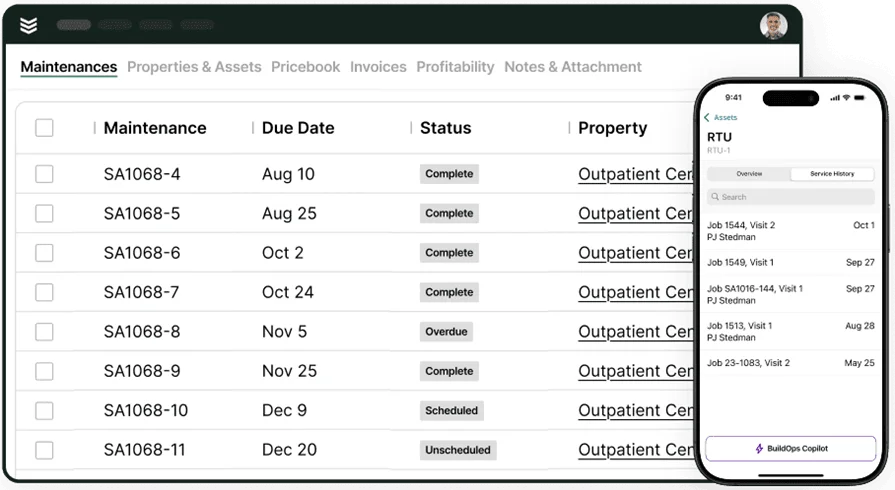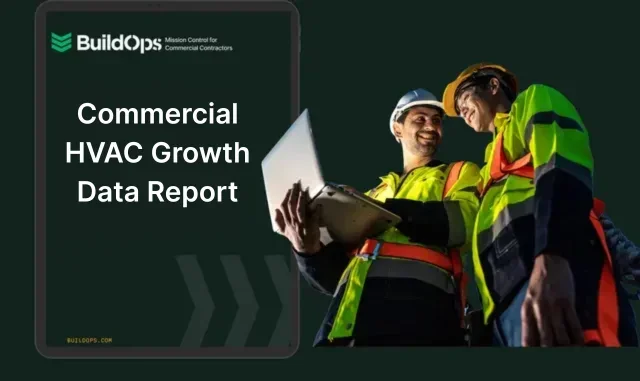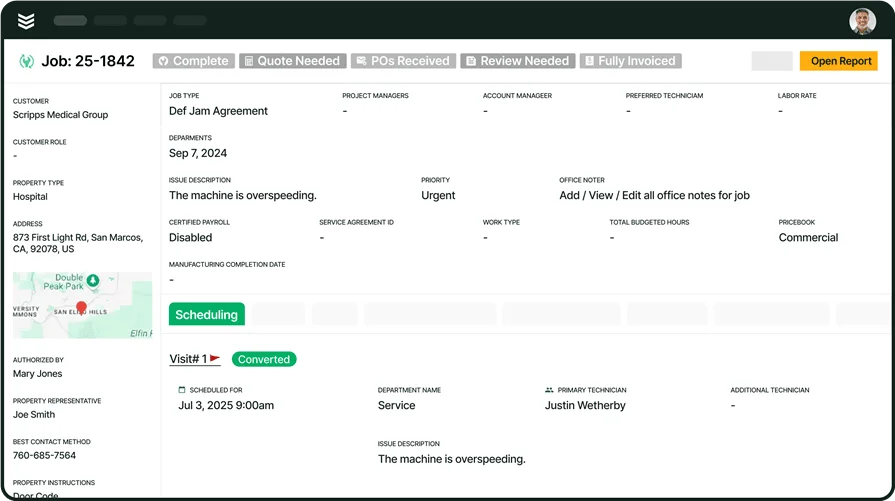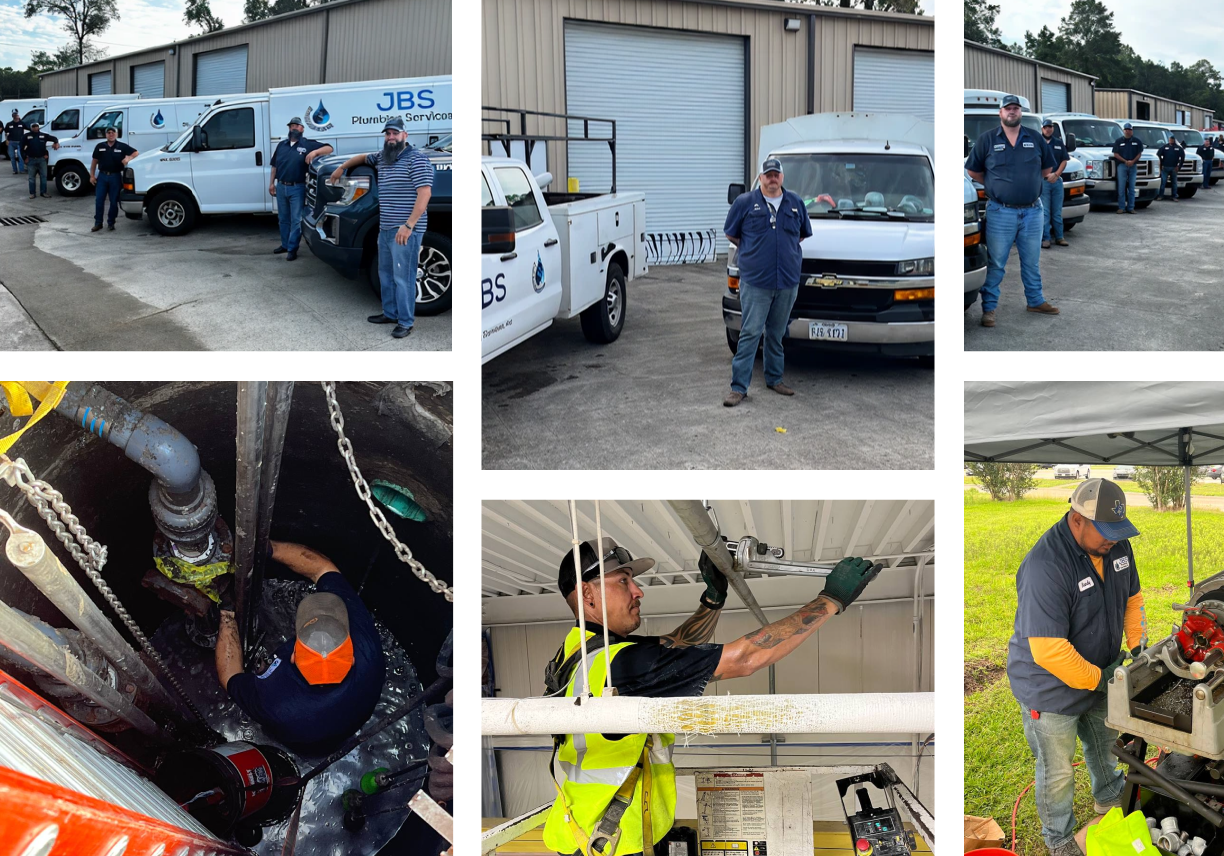Running both HVAC and plumbing under the same roof brings a different kind of challenge. You’re not just managing a service feature like estimating or invoicing—you’re managing two entire trades. That means two sets of workflows, two types of jobs, and often, two crews.
HVAC plumbing software is built for this dual setup, helping shops keep everything in sync—from dispatch and scheduling to job history and billing. Teams leaning on an HVAC service platform or integrated plumbing contractor software are cutting down on chaos by using tools that support both trades in one system.
Whether it’s a furnace install or a repipe, the goal is the same—get the job done right, fast, and without confusion between teams. This guide walks through what to look for in a platform, what tools handle HVAC and plumbing best, and how to build a system that keeps every job moving.
- How to choose the right HVAC plumbing software for your team
- 5 key features to look for in an HVAC plumbing software
- 5 best HVAC plumbing software for contractors
- 7 benefits of using an HVAC plumbing software
- 3 important HVAC plumbing software FAQs answered
Let’s kick things off with how to pick the right HVAC and plumbing solution for your business — and what questions you should be asking before making a move.
How to choose the right HVAC plumbing software for your team
Choosing software that serves both trades isn’t just about convenience—it’s about control. HVAC and plumbing each come with their own set of demands. Some tools work great for heating and cooling but fall flat when it comes to water systems and piping. And others focus on plumbing workflows but ignore the scheduling and service needs that HVAC teams face every day. The best HVAC plumbing software covers both, without compromise. Ask these questions before making a call:
- Team setup - How do your HVAC and plumbing crews operate—together or separately? Do techs cross over between trades, or are their schedules completely different? Who needs access to schedules, job details, or customer history in real time?
- Service focus - Are your jobs mostly residential, commercial, or a mix of both? Do you handle installs, repairs, inspections—or all of the above? Do you need your software to adapt to different job types across both trades?
- Workflow bottlenecks - Where do handoffs break—between office and field, or between HVAC and plumbing crews? Are techs constantly calling in for job updates they should already have? Is billing held up because job details or time logs aren’t shared fast enough?
- Scalability - Are you planning to grow your HVAC and plumbing teams this year? Will the software still work if you add a new service area or offer maintenance plans? Can it support multiple crews, dispatchers, and admins without getting clunky?
- Features - Does it support shared dispatching for HVAC and plumbing jobs? Can it track equipment, service history, invoices, and customer data in one place? Does it work as a unified plumbing & heating software—not two separate tools stitched together?
Once you’ve got answers to these, it’s time to dig into the features that actually make a difference on the ground. Let’s walk through what those look like next.
5 key features to look for in an HVAC plumbing software
HVAC and plumbing service isn’t about sitting still. You’re managing calls for broken heat exchangers, pipe leaks, clogged vents, and tenant complaints—all in the same day. The best HVAC plumbing software helps crews move quickly, communicate clearly, and avoid getting buried in manual processes.
Let’s say your HVAC team is finishing a rooftop unit service while your plumbing crew hits a hospital basement for a drain line inspection. Neither job should slow down just because someone needs a paper work order or can’t get updates. That’s where these features make the difference.
1. Scheduling and dispatching
A calendar is just the start. You need field service scheduling that’s built for both HVAC and plumbing work—where tech availability, job type, and territory all play a role. Combined with dispatching software, it becomes a live command center that adjusts as things change. Let’s say you’ve got an open time slot after a pipe repair wraps early. With real-time visibility, dispatch can slide in an HVAC filter replacement nearby—same truck, no extra miles. Without it, that hour just vanishes.
2. Mobile app for techs
The crew in the field can’t wait on emails or second-hand notes. A technician mobile app gives your team everything they need—service history, job notes, asset photos, and task checklists—all from the truck or the basement. Think of a plumbing tech sent out to inspect a commercial backflow system. Midway through, they flag a ventilation issue tied to the HVAC return. Instead of calling it in, they log the issue, snap a photo, and tag it for follow-up—all without leaving the job.
3. CRM with multi-trade history
HVAC and plumbing customers expect you to know their equipment, issues, and property details. Having CRM access made for both trades, keeping everything in one place—so you’re not digging through spreadsheets to see who serviced what. Say your team did a heating repair for a school six months ago. Now they’ve called about a leak in the lower-level restrooms. Your office pulls up every visit, note, and asset tied to the building—no calls to field techs or guesswork needed.
4. Invoicing and payments
Wrapping up a job is only half the battle—the other half is getting paid without delays. With field service invoicing tied directly to your job data, and payment processing tools built in, HVAC and plumbing teams can send accurate invoices fast and give customers easy ways to pay on the spot. Let’s say your crew finishes up a water heater replacement and knocks out a thermostat swap on the same visit. Instead of waiting days to generate separate invoices, the job details feed directly into a combined bill. The customer reviews it and pays digitally—before your team even leaves the driveway.
5. Service agreement tracking
Repeat business in HVAC and plumbing comes from maintenance contracts, inspections, and long-term clients. With service agreement management, you can keep track of upcoming tasks, contract terms, and expiration dates—without a wall of sticky notes. Consider a property management company that calls every fall for HVAC startup and every spring for backflow testing. Instead of relying on memory or random reminders, the software flags the dates, assigns the crew, and adds the tasks to the calendar weeks ahead.

Check out our job management suite
No matter your profession, we keep projects organized and on track.
Other notable HVAC plumbing software features to have
While the core features handle scheduling, dispatch, invoicing, and field communication, the best HVAC plumbing software doesn’t stop there. Add-on tools that support reporting, estimates, and long-term tracking can help keep your business one step ahead—especially as jobs stack up and customer needs shift across HVAC and plumbing services.
- Quoting tools – A quoting solution helps teams generate professional estimates on the spot. This is especially useful when technicians identify add-on work mid-job, or when an HVAC inspection leads to a separate plumbing repair. Quick turnaround on quotes means you don’t lose the upsell.
- Fleet tracking – A fleet management tool helps keep tabs on every vehicle, from fuel levels to equipment storage. For businesses running HVAC and plumbing vans across a region, this tool cuts down on delays and keeps jobs moving—especially when coordinating multiple stops in one day.
- Technician time tracking – Time tracking software makes it easier to log hours per job, trade, or project. It also helps verify labor costs for mixed-scope work, like HVAC tune-ups paired with pipe replacements. This kind of tracking helps you bill with confidence and avoid underestimating labor.
Now that you know which features matter most—and which ones add extra value—it’s time to dive into the top HVAC plumbing software picks on the market. Let’s break down what each platform brings to the table.
5 best HVAC plumbing software for contractors
Finding HVAC plumbing software that actually fits your crew’s workflow takes more than checking boxes. The system needs to handle real-life service conditions—techs in the field, mixed-scope jobs, office coordination, and tight turnarounds.
Whether your team handles commercial installs, residential repairs, or a mix of both, these five tools stand out for how they support HVAC and plumbing operations side-by-side.
1. Best for commercial: BuildOps
BuildOps is built specifically for commercial service teams, offering powerful tools that connect field techs, dispatchers, and the office. It combines scheduling, dispatch, asset tracking, quoting, and reporting into a single workflow that fits both HVAC and plumbing needs. The platform stands out for its real-time technician updates, customizable checklists, and advanced reporting tools.
How pricing works: Custom pricing based on team size and business complexity.
What sets it apart: Handles large-scale HVAC and plumbing operations with shared scheduling, unified asset history, and deep integrations for both trades.

Take a closer look at BuildOps
We support HVAC pros and plumbers manage complex jobs to completion.
2. Best for residential: Payzer
Payzer is a financial tool and field service platform that leans heavily into residential HVAC and plumbing work. It offers payment processing, scheduling, and service agreements in one place, along with integrations like QuickBooks and Stripe. It’s a good fit for small residential service teams that need mobile-friendly tools for quick quoting and collections. That said, Payzer may not be the best fit for commercial HVAC and plumbing contractors handling multi-site projects or mixed-scope jobs.
How pricing works: Tiered pricing depending on features and team size, with add-ons for advanced tools.
What sets it apart: Combines payments, estimates, and job management into a mobile-first tool tailored for fast-paced residential service teams.
3. Best for general contractors: H2X
H2X is geared toward engineers and general contractors who manage HVAC and plumbing system design. It offers cloud-based tools that handle pipe sizing, system modeling, and layout optimization. Great for firms that need more technical control over layouts and performance data before the work starts. However, H2X may not be ideal for day-to-day service teams that need dispatching, invoicing, or mobile workflows for techs in the field.
How pricing works: Subscription-based model with plans starting for individual users and scaling up for design teams.
What sets it apart: Designed for HVAC and plumbing professionals who handle design and engineering in-house—especially those working on new construction or large retrofits.
4. Best for small to mid-sized businesses: VAI ERP
VAI ERP is a flexible enterprise resource planning platform built for small to mid-sized service businesses. It offers tools for service management, inventory tracking, quoting, and customer communication. For HVAC and plumbing teams that want one system to handle job workflows and back-end operations like payroll or inventory, it can cover a lot in one place. That said, VAI ERP can feel too broad or overly complex for field-focused contractors looking for a more intuitive, trade-specific platform.
How pricing works: Custom pricing depending on module selection, business size, and configuration needs.
What sets it apart: Combines service task tracking with business tools that help HVAC and plumbing teams grow into more advanced operations.
5. Best for HVAC & plumbing design: Aft Fathom
Aft Fathom is a system modeling and simulation tool used for designing HVAC and plumbing systems under precise flow and pressure conditions. It’s often used by design engineers to optimize layouts before construction begins, making it ideal for firms involved in system planning. However, Aft Fathom is highly technical and not suitable for day-to-day HVAC plumbing service teams focused on dispatching or field operations.
How pricing works: License-based pricing model, generally purchased per user with available academic and commercial licensing tiers.
What sets it apart: Delivers advanced modeling capabilities that help HVAC and plumbing professionals engineer safe, efficient systems before any work hits the field.

Get the HVAC Growth Report
See how leading plumbing & HVAC pros are able to achieve business growth.
7 benefits of using an HVAC plumbing software
Running HVAC and plumbing under one system doesn’t just make operations smoother—it changes how teams handle growth, reporting, customer relationships, and day-to-day chaos. Great HVAC plumbing software isn’t about stacking on more tools. It’s about bringing clarity, speed, and control across both sides of the business. These benefits go beyond checklists and calendars—they speak to how your team actually works, and where the gains show up.
1. Faster team communication across both trades
When dispatch, techs, and the back office are synced in one system, everyone moves faster. HVAC and plumbing teams can see real-time job updates, track availability, and reroute without phone tag or duplicate entries. This kind of communication gap gets addressed in detail in our contractor dispatch management guide, especially when both trades are operating on tight timelines.
2. Smarter decision-making from connected customer data
With centralized customer profiles, both HVAC and plumbing crews can see job history, equipment notes, and past issues in one place. It makes service calls more efficient and follow-ups more accurate. If you’re working toward better retention and proactive service, this kind of setup supports insights like the ones explored in this contractor CRM breakdown.
3. Cleaner invoicing with less back-and-forth
When HVAC and plumbing teams both feed into one invoicing system, there's less room for errors. Job data flows straight into billing, saving time and reducing missed charges. This is especially useful when paired with workflows outlined in both the HVAC invoicing and plumbing invoicing guides, where field data directly drives the final bill.
4. Reduced downtime and faster job turnaround
With better coordination and tracking tools, HVAC and plumbing teams spend less time waiting—on updates, on parts, or on approvals. Software that maps out workflows for both trades helps eliminate the bottlenecks that usually stall service jobs. It's one of the most overlooked ways companies improve efficiency, especially in complex service schedules.
5. More control over business growth
The best HVAC plumbing software doesn’t just keep operations running—it helps identify where the business is growing, and where it’s leaking time or money. Detailed dashboards and reporting tools help contractors make moves confidently, supported by data like what’s explored in this plumbing company growth breakdown.
6. Insight into commercial service trends
Commercial HVAC and plumbing companies need more than just tools—they need visibility into how their market is shifting. The right platform gives insight into what types of jobs are rising, where schedules are tightening, and how crews are responding. These themes are reinforced by patterns highlighted in the commercial HVAC growth report, showing how top-performing teams adapt.
7. Easier training and onboarding
When everything lives in one place—job details, customer notes, technician checklists—it’s easier to get new techs up to speed. HVAC and plumbing workflows follow similar structures in the best platforms, making the learning curve shorter and the ramp-up time faster. It’s a major win for busy service managers who don’t have hours to spend training every new hire.
3 important HVAC plumbing software FAQs answered
When it comes to HVAC plumbing software, there’s a lot of noise—and not much clarity. Contractors want to know what it actually does, how it works in the field, and whether it pays off. These are the questions that come up most when teams start looking into platforms that support both HVAC and plumbing.
1. What is HVAC plumbing software?
HVAC plumbing software is a digital platform that helps contractors manage jobs, dispatch, scheduling, billing, and customer data across both HVAC and plumbing work—keeping everything in sync from the office to the field. The best systems should be able to support workflows that cross trades.
Having software that supports both HVAC & plumbing teams gives them one place to track jobs, manage crews, invoice clients, and keep records up to date—whether it’s ductwork or drain lines.
2. How does HVAC plumbing software work?
At its core, the software connects the moving parts of HVAC and plumbing operations in one dashboard. Here's how it typically functions:
- Dispatchers assign jobs based on tech availability, location, and skill set
- Techs access tasks, notes, and service history through a mobile app
- Job updates, labor hours, and parts used flow back into the system automatically
- Office staff generate quotes, track work completed, and send invoices from one place
This level of connectivity helps HVAC and plumbing teams stay aligned—especially when working on fast-turnaround service jobs or larger commercial installs.
3. Is HVAC plumbing software worth the cost?
For most contractors, yes—and here’s why. When both HVAC and plumbing workflows live in one system, you save time, reduce mistakes, and get paid faster. Techs spend less time on the phone or writing up paperwork. Office staff don’t have to chase down job info.
Over time, these gains add up—helping you win back billable hours, improve customer experience, and avoid the hidden costs of operating across disconnected systems. Whether you're scaling or just trying to tighten things up, the return is hard to ignore.
Finding HVAC plumbing software that handles both trades without shortcuts can be a game-changer. The best tools bring dispatch, invoicing, quoting, and service tracking into one system—cutting down on double-entry, miscommunication, and missed revenue. What sets top platforms apart isn’t just feature count—it’s how those features are built to handle real HVAC and plumbing workflows, not just generic service calls.
Most tools make you bolt on plumbing work or patch together HVAC processes. Platforms like BuildOps bring it all under one roof—with field-ready tools made specifically for commercial service contractors juggling both sides of the trade. Features like real-time dispatch, mobile tech access, invoicing, and customer tracking come standard—not as costly add-ons.

Want to see BuildOps in action?
We help HVAC & plumbing teams streamline operations and get more work done.








